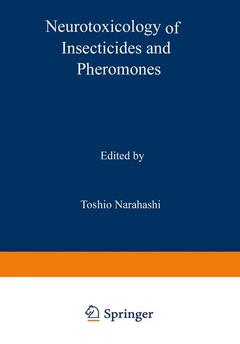Description
Neurotoxicology of Insecticides and Pheromones, Softcover reprint of the original 1st ed. 1979
Coordinator: Narahashi Toshio
Language: English
Subject for Neurotoxicology of Insecticides and Pheromones:
Publication date: 02-2012
308 p. · 17.8x25.4 cm · Paperback
308 p. · 17.8x25.4 cm · Paperback
Description
/li>Contents
/li>
Substantial progress has been made during the past three decades in the development of a variety of chemical means to control insect pests. A large number of highly effective insecticides have been developed, and many of them have contributed to a great extent to increasing agricultural productivity and eradicating diseases transmitted by vectors. However, contamination of our environment caused by various pesticides has become a serious problem, and various attempts have been made to develop newer methods of con trolling insect pests. One of the approaches is to develop newer insecticides which cause less contamination of the environment without losing their insecticidal potencies. Another approach, among other things, is to utilize pheromones to control certain species of insects. No matter what approach one may choose, it is imperative to understand the mechanism of action of pesticides for efficient development and utilization of these chemicals. One important feature common to most insecticides and pheromones is their inter action with the nervous system which is the main target site. Thus the mechanisms of action of these chemicals on the nervous system represent one of the most critical aspects in pesticide toxicology. In comparison to the chemical and biochemical studies dealing with the metabolism of various pesticides, the study of neurotoxicology has lagged behind to a considerable extent for various reasons. Technical complications involved in neuroto- co logical experiments appear to be one of the contributing factors.
Introduction: Nervous System as a Target Site of Pheromones and Insecticides.- Pheromone Perception in Lepidoptera.- Pheromone and Host Odor Perception.- Chemoreceptor Proteins.- Mode of Action of Insecticides: Insights Gained from Neurophysiological Preparations of Intact or Dissected Insects.- An Analysis of the Temperature-Dependence of the Toxicity of Allethrin to the Cockroach.- The Comparative Neurotoxicity of Formamidine Pesticides.- Action of Dieldrin and Related Compounds on Synaptic Transmission.- Effects of Parathion on the Mammalian Nervous System.- Effects of Insecticides on the Sensory Nervous System.- Nerve Membrane Ionic Channels as the Target Site of Insecticides.- Characteristics of DDT-Sensitive Ca-ATPase in the Axonic Membrane.- Interaction of Insecticides with Acetylcholine Receptors.- Effect of Structure on the Interaction of Organophosphorus and Carbamate Esters with Acetylcholinesterase.- Contributors.
© 2024 LAVOISIER S.A.S.




